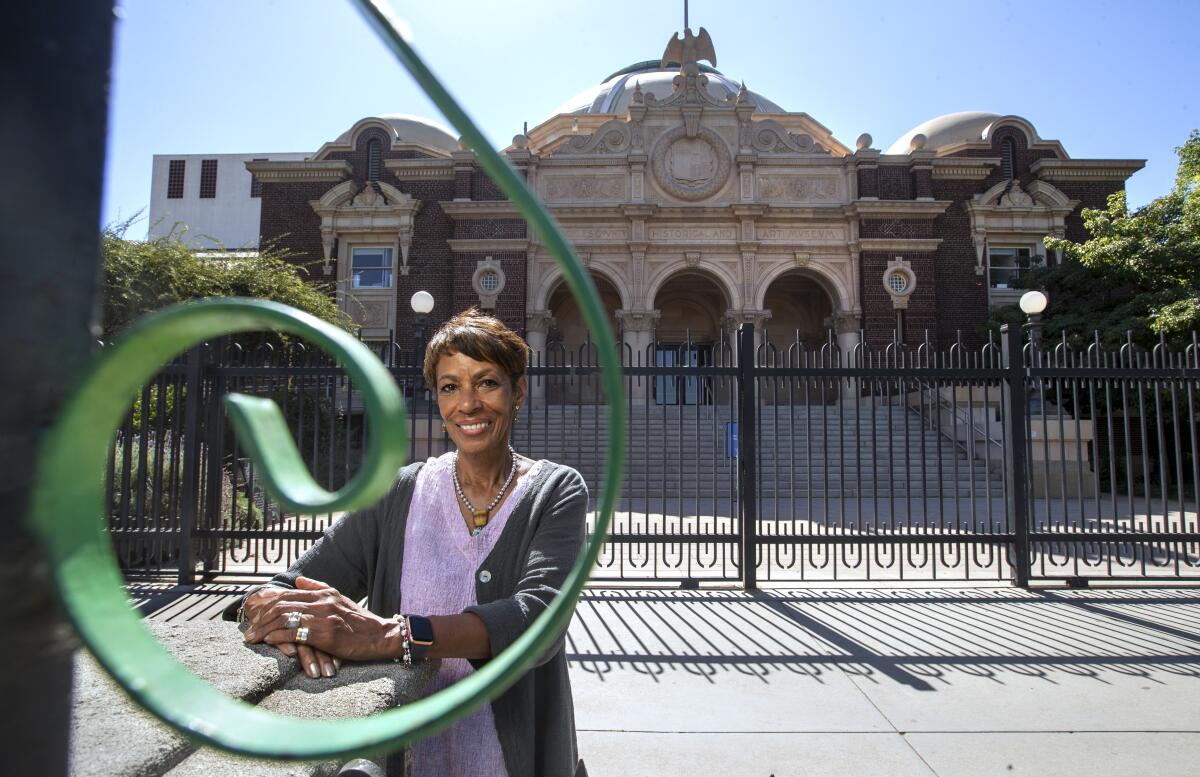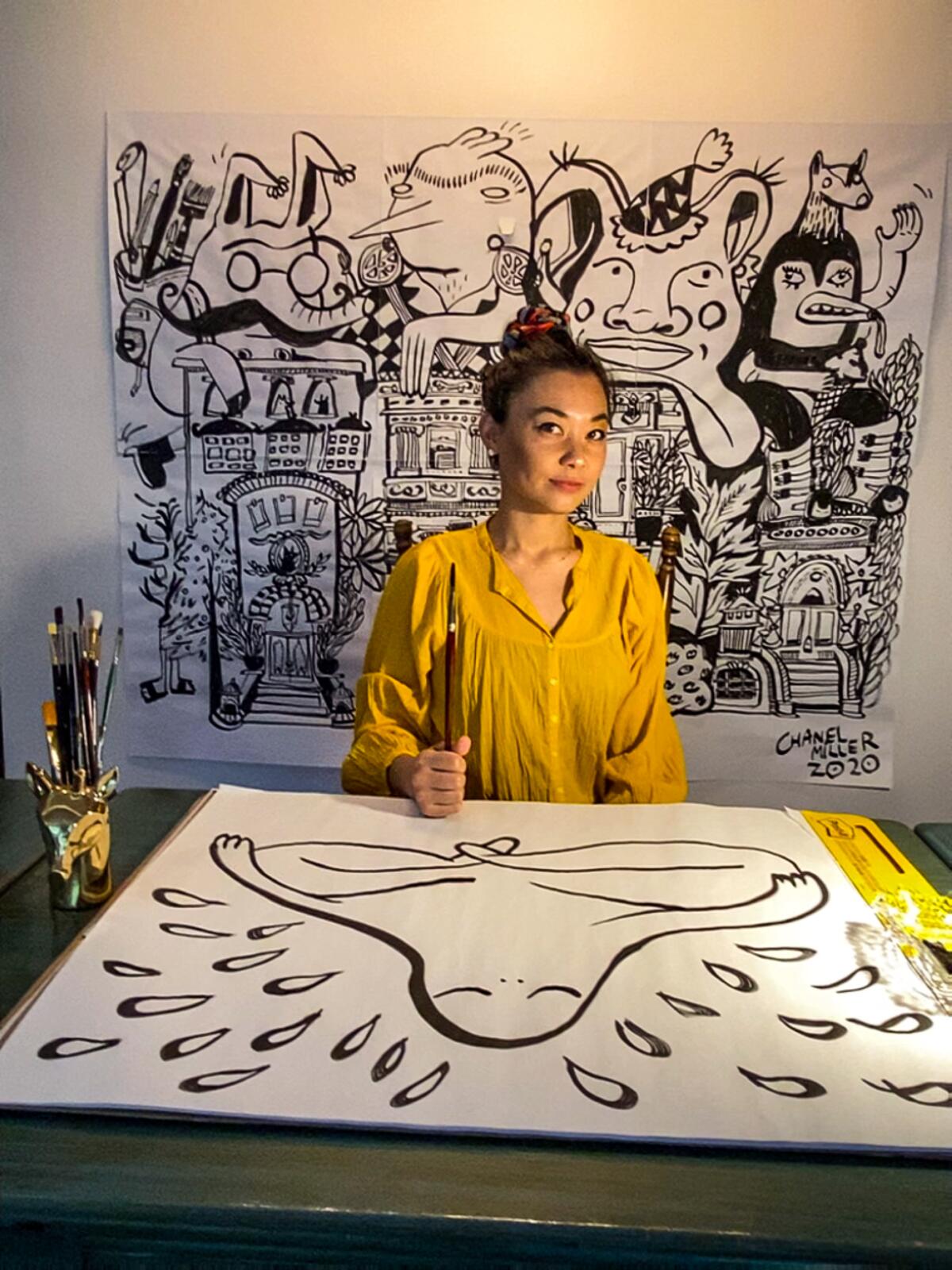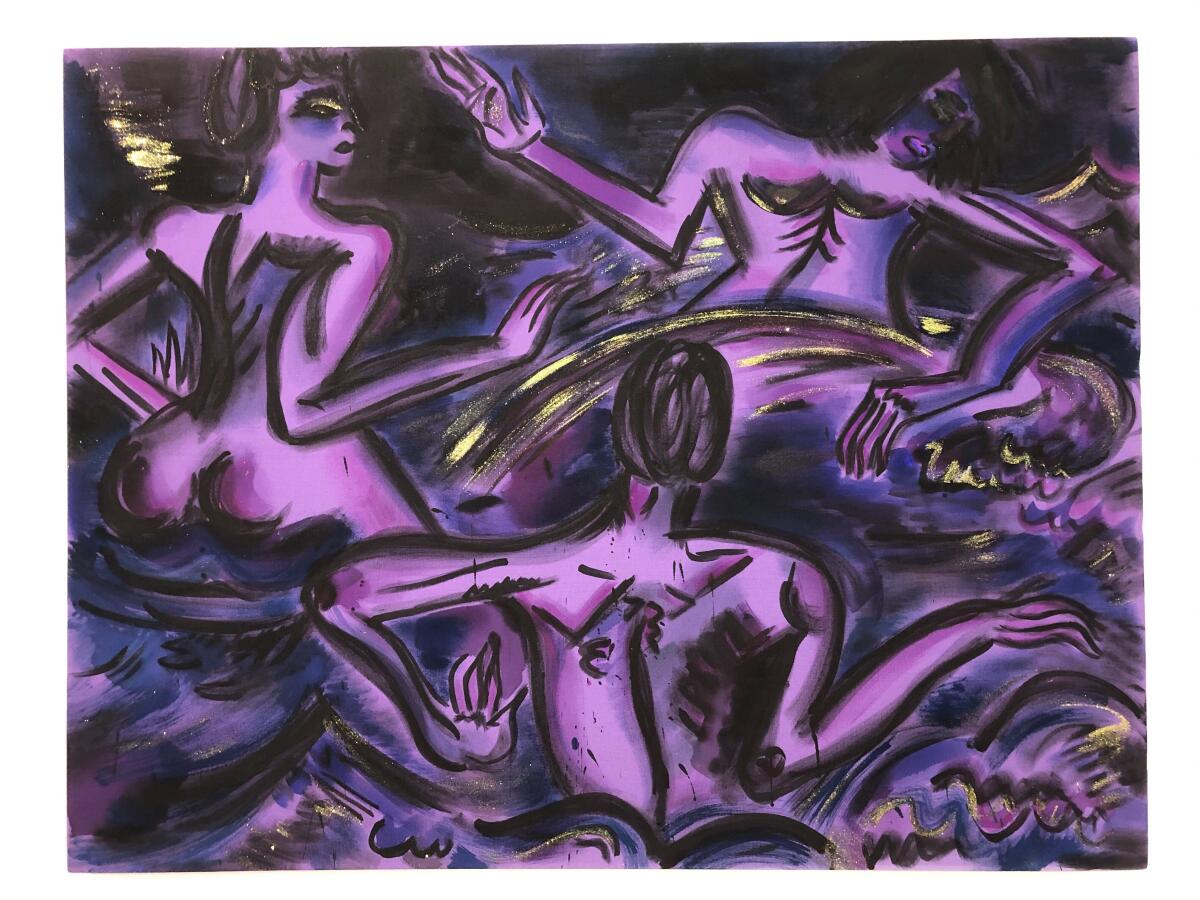Essential Arts: The art of women’s rights, the staging of the DNC
- Share via
Hello, fellow kids! I’m Carolina A. Miranda, staff writer at the Los Angeles Times, reporting live from Contagion 2020, on what’s going down in the world of culture — and fortune telling.
Women’s rights
A new exhibition organized by L.A.’s Natural History Museum brings together ephemera connected to women’s rights on the centennial of the ratification of the 19th Amendment. This includes buttons, fliers, ballots and protest signs, as well as interviews with women about their experiences with voting, including those — like Black women — who may have been prevented from doing so. Times intern Dessi Gomez reports on the show, which features a virtual component that will serve as a teaser to a physical exhibition, which the museum hopes to open in October.

Sort of related: The New York Times has an interesting story on how artist Jeanine Michna-Bales is paying tribute to Inez Milholland, a lawyer and activist who collapsed on a Los Angeles stage in 1916 while “pleading with more than a thousand women ... to stand together in the battle for women’s suffrage.”
Chicano protest
Since I’m on the subject of protest: The Times is about to unveil a collection of reports to mark the 50th anniversary of the Chicano Moratorium on Aug. 29. The moratorium was an anti-Vietnam War rally held in East L.A. that was intended to protest the high toll the war was taking on Mexican Americans. It ended in bloodshed at the hands of sheriff’s deputies, with three people dead — including Times columnist and KMEX news director Ruben Salazar.
Make the most of L.A.
Get our guide to events and happenings in the SoCal arts scene. In your inbox every Monday and Friday morning.
You may occasionally receive promotional content from the Los Angeles Times.
The series includes stories about the legacy of that fateful day throughout politics and culture. And it couldn’t be more timely: We live in a moment in which issues of civil liberties are top of mind, as are police crackdowns against working press.
Stories will appear in Sunday’s paper and will go live early on Sunday morning at this link.

The convention and culture
Times theater critic Charles McNulty tuned into the Democratic National Convention and reports that the most stirring testimonial came not from one of the big politicos but from a 13-year-old boy named Brayden Harrington, who like Biden, stutters. McNulty, who also stutters, says he found the young man’s courage remarkable. “For Brayden to deliver a speech of this magnitude he had to navigate two gulfs: the physical gulf within himself and the gulf between himself and an anonymous public, whose reaction to communication snafus is unpredictable and not always patient or friendly.”
TV critic Lorraine Ali liked that Kamala Harris didn’t apologize for her ambition in her DNC speech accepting the nomination for vice president. Ali also observed the “you’re fired” speeches directed at Donald Trump on the convention’s second day and thought that the telethon-like tone of the convention’s opening night wasn’t a bad thing.
One of the most universally praised segments of the convention was the virtual roll call, in which delegations around the country checked in from their home states — a visual sequence that allowed convention audiences to tour the country in minutes.
It was the Texas delegation in El Paso that handily won the night in the aesthetics department. U.S. Rep. Veronica Escobar, dressed in white, was beautifully illuminated as she stood before a mural titled “Ánimo Sin Fronteras” by L.A. artist El Mac, made in collaboration with David Herrera. The mural was completed in 2014 and depicts Melchor Flores, whose son was abducted by police in Nuevo León, Mexico, in 2009. In the wake of last year’s tragic mass shooting in El Paso the image has come to represent the city’s strength and resilience.

Coronavirus and the arts
The L.A. Phil is launching a new series called “Sound/Stage” — recorded by the orchestra in an empty Hollywood Bowl — that will roll out weekly starting Sept. 25. “When COVID shut us down, it also silenced us,” CEO Chad Smith told The Times’ Deborah Vankin. The shows will allow the orchestra to come together, but “also respond to this moment, to COVID and the Black Lives Matter movement and other contemporary real-time issues. That’s why we did it.”
Enjoying this newsletter? Consider subscribing to the Los Angeles Times
Your support helps us deliver the news that matters most. Become a subscriber.
As venues remain closed, Times classical music critic Mark Swed files another dispatch in his series devoted to listening. This week he tunes in to composer George Lewis’ “Shadowgraph 5,” a work that “evades all but the most sensitive new-music radar.” This free-form piece can be for any number of players and can last for any amount of time. What he has found resonant in this ever-changing work is “the reproduction through sound of the mental processes through which powerful ideas are formulated in discourse, the adrenaline rush of a communal brainstorm that takes over your senses and wildly elevates your mood.”
The pandemic and the subsequent civil rights uprisings have laid bare the issue of inequities in museum pay, writes Robin Pogrebin in the New York Times. In addition, Matt Stromberg and Gareth Harris report for Apollo magazine on whether museums could have done more to protect jobs. “While some board members have chipped in during this difficult time,” writes Stromberg, “it can be a challenge raising money for general funds like payroll.”
The AIA’s architecture billings index from July shows that the design field is in a state of contraction.
And the Mariinsky Ballet staged a comeback — which was halted by a coronavirus outbreak.
LACMA down
Deborah Vankin reports on the demolition of several LACMA buildings that are being razed to make way for a new structure designed by Swiss architect Peter Zumthor. A rep for the museum says that the $750-million building project is on schedule — with completion planned for the end of 2023.

An artistic debut
In 2019, Chanel Miller published the memoir “Know My Name,” revealing that she was the unnamed young woman in a highly publicized sexual assault case at Stanford University. This month, she is making a public appearance very much on her own terms: The lifelong illustrator is opening a show of her work at the Asian Art Museum in San Francisco. The 70-foot-long mural, titled “I was, I am, I will be,” is visible from the street. “The ability to sit with uncertainty is something we’re all learning right now because we have to,” she tells Times contributor Todd Plummer. “It’s about how to nourish ourselves with what we have and where we are.”

Essential image
Instagram has become a way for me to visit artists’ studios amid the pandemic. Lately I’ve been captivated by the work of Cuban-born artist Alexandre Arrechea. (Find him at @alexandrearrechea.) Arrechea, who once formed part of the collective Los Carpinteros, recently started working on a series of watercolor paintings that toy with illusion and depth and often have me asking what it is I’m looking at exactly. The work shown below is a flat, watercolor painting intended to mimic a painting on cardboard. (The drippy background is his studio wall.)
The pieces, he tells me, are inspired by “the philosophy of making more with very little” — which seems just right for creating work in pandemic conditions. (Someone in L.A. please give him a show because I’d really like to see these in person.)
Passages
Charles McNulty pays tribute to the multifaceted Eric Bentley, the author, critic, translator and playwright who died earlier this month at the age of 103. “Few are around to testify to the impact of Bentley’s critical writing,” says McNulty, “the way it incited new modes of thought and, just as crucially, revealed the limitations of the prevailing wisdom.”
William S. Arnett, an art collector who championed the work of self-taught Black artists from the South such as Thornton Dial, and the quilters of Gee’s Bend, has died at 81.
Ron Gorchov, a painter known for his saddle-shaped canvas drenched in solid colors and minimal forms, is dead at 90.
Essential happenings
Matt Cooper rounds up the 16 culture picks for the weekend, including the La Jolla Music Society’s SummerFest 2020 and a streaming series of past concerts staged by the L.A. Phil at the Hollywood Bowl — those good ol’ days when we could gather in crowds. As always, find Cooper’s complete culture listings at Things To Do: Arts & Culture.
If you need art IRL but aren’t ready to hit an indoor space, artist Gabriel Garza has been organizing installations in his backyard in Silver Lake. Punto Lairs, as this improvised exhibition space is called, is available for viewing by appointment (via their website). Their current exhibition, featuring work by Cameron Cameron and Symrin Chawla, is on view through Sept. 5.
The Broad has been doing a series of reports titled “Up Close,” each of which examine, in depth, a single work in the collection. I really enjoyed this one, which examines a painting by Julie Mehretu inspired by the Arab Spring. Find the whole series here.
Night Gallery is marking its 10th anniversary with the group show “Majeure Force,” which is on view for one more week. While the gallery has placed images online, many of the works bear viewing in person — including an elaborate cut-paper painting by Khari Johnson-Ricks, a wry wall installation of a dining table by Samara Golden, a quilted painting by Anne Libby and a large canvas by Mira Dancy showing bathing figures in resplendent shades of purple. Don’t miss the ceramic vessels by Jasmine Little in the courtyard. The show is on view through Aug. 29; timed visits are available through the website.

Right across the way, François Ghebaly has a show of paintings by Cassi Namoda on view, as well as the group show “Materia Medica.” The latter was organized by Kelly Akashi and explores the ways in which nature has been subjugated to human need. Highlights include some beguiling paintings by Evelyn Statsinger that toy with nature’s patterns and works by Candice Lin that pay tribute to the medicinal powers of flora.
“Materia Medica” is on view through Sept. 4, while Namoda’s paintings will remain up until Sept. 20. Timed visits are available through the website.
In other news
— An appeals court in California has ruled that the Thyssen-Bornemisza Museum in Madrid can keep a painting by Camille Pisarro that was looted by the Nazis.
— The Getty and Belgium’s Royal Institute for Cultural Heritage have upgraded the Ghent Altarpiece website with fresh, post-conservation imagery and a higher resolution, so that it’s possible to zoom in on the tiniest details.
— Andrew Russeth writes about why saving the U.S. Postal Service also involves saving a lot of important American art.
— Tokyo’s high-design toilets.
— The New Mexico-based dance company Dancing Earth is not only thinking about how they might decolonize dance, but how they can form a bond to Indigenous communities through collective creation.
— The world needs more dance challenges set to “WAP,” the racy hit song by Cardi B and Megan Thee Stallion.
— Essential listening: I was riveted by this episode of Jenna Wortham and Wesley Morris’ “Still Processing” podcast, about how we, as a culture, might contend with the legacy of images such as Aunt Jemima. (Hint: It involves reparations and honest accounting of the image’s history.)
— The Huntington has launched a new fellowship in honor of novelist Octavia E. Butler that invites applicants who touch on “ideas and issues explored by Butler in her published works.”
— The Center Theatre Group’s Leslie K. Johnson has joined the Skirball Cultural Center as executive vice president.
— Are you subscribed to singer Nick Cave’s newsletter? He answers fan questions openly, vulnerably and honestly. Highly recommend.
And last but not least ...
Because we all would like to divine the future right about now: The L.A. Public Library comes through with a post about tarot cards.
The biggest entertainment stories
Get our big stories about Hollywood, film, television, music, arts, culture and more right in your inbox as soon as they publish.
You may occasionally receive promotional content from the Los Angeles Times.




